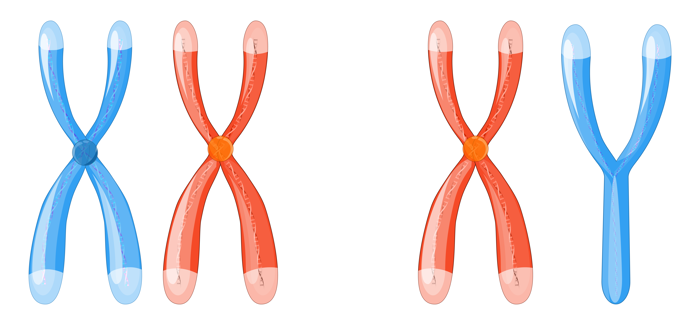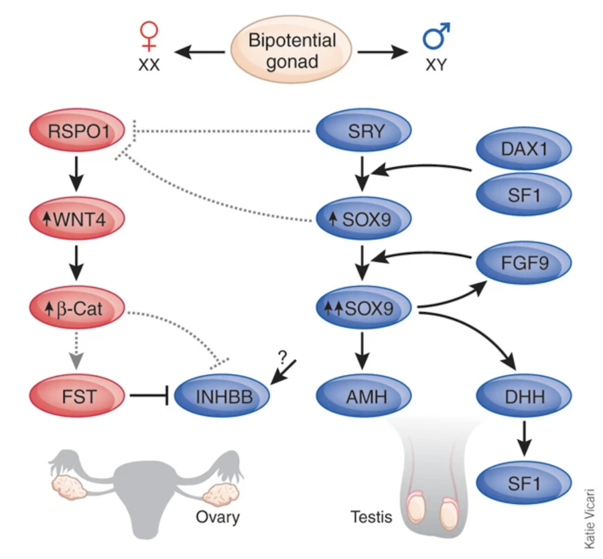
How do the X and Y chromosomes differ and how does that contribute to sex determination?
March 14, 2012

- Related Topics:
- Genetic sex,
- Y chromosome,
- Developmental biology,
- Chromosomes
An elementary school student from California asks:
"What is the big difference about the X and Y chromosomes that make the difference between male and female people? Do the cells just generate differently?"
Note: This article is discussing how X and Y chromosomes contribute to biological sex, which is distinct from gender and gender identity. When we discuss male and female in this article, we are solely referring to how the X and Y chromosomes contribute to attributes that are considered defining of biological sex.
You're right that it just isn't having an X and a Y chromosome that makes a male (or that having two X's makes you a female). It is what our cells do with these chromosomes that makes an embryo develop as male or female.
Specifically, there is a gene on the Y chromosome called SRY that makes a big difference. This gene tells the embryo to develop male features. Without the signals from the SRY gene, embryos develop into females.

One way we know about this important gene is that there are some rare cases where someone has two X's but also has an SRY gene. These people present with male features. And there are cases where an XY person has an SRY that doesn't work or is missing. These people present as female.
But we also know the SRY gene isn't enough. There are lots of genes needed for an embryo to develop male features.
What the SRY gene does is start something called a gene cascade. This is sort of like an avalanche.
The SRY gene turns on some genes that are critical to developing male anatomy and features, and those genes turn on some more genes, and so on. Eventually you get a whole different set of genes working differently than they would without the SRY gene there.
So in a sense the male cells do generate differently from the female cells. Each has a different gene program turned on that leads to being male or female. Though with a few exceptions, cells between males and females aren’t wildly different. For example, heart cells look pretty much the same in males and females.
But as you'll see, all the genes on the Y chromosome aren't the only genes involved in making a male. Lots of the other chromosomes are involved too.
It Takes a Village (of Genes) to Make a Boy
Most people have 23 pairs of chromosomes. The numbered pairs (1-22) are called autosomes, and they are the same in males and females.
The 23rd pair is the sex chromosomes. These are the ones that are different in males and females. Males have an X and a Y and females have two X chromosomes.
Scattered across all of these chromosomes are over 20,000 different genes. Each gene has the instructions for doing a particular thing in a cell. All of these different genes work together to make you.
Both males and females share almost all of the same set of genes. The difference is the 80 or so on the Y chromosome. Only males have those.
But these 80 aren't enough to make a male. Genes on lots of the other chromosomes are involved too.
Let's look at a quick example to give you a feel for what I mean. One of the first genes that SRY turns on or activates is called SOX9. This gene is found on chromosome 17.
This means that XX and XY individuals both have this gene. It is just that without SRY, it stays off.
There are at least 5 other genes that come on early that have instructions for developing male characteristics. They are located on different chromosomes like the X chromosome and chromosomes 9, 11, 17, and 19. Some of them are turned on by SRY or by genes like SOX9.

This is actually how lots of things work in cells. Every cell has the potential to be a muscle, a blood cell, or any of the other hundreds of cell types. Cell type is determined by what genes are on and off.
Developing as a maleis a bit different though. Not only are genes used differently, but there are also a few extra genes needed to make a male.
Even though males have those 80 of so extra genes on the Y chromosome, one of the most important genes in determining sex is called the androgen receptor (AR). And it turns out that this gene is actually on the X chromosome!
Halfway There
A key step in male development is getting some testosterone made. I am sure you've heard of testosterone. It’s often referred to when we talk about puberty in males, but males and females both make testosterone (though at very different levels).
But it is also turned on early in development to make an embryo male. One of the key jobs of SRY and its related genes is to get testosterone made so the AR gene can do its job. And AR is responsible for signaling the primary sexual characteristics of males.

Sometimes though, someone can get a copy of the AR gene that isn't working quite right. In these cases, the primary sexual characteristics don’t develop fully as a male. This is called Androgen Insensitivity Syndrome (AIS).
There are two types of AIS, partial and complete. Individuals who have complete AIS are genetically male (XY), but they have the physical characteristics of a female. People with partial AIS are also XY but tend to have incomplete development of male sexual characteristics.
Even though AR is on the X chromosome, it obviously plays a key role in determining male sexual characteristics. So you're right, an XY individual’s boy's cells are programmed differently than an XX individual’s. But it takes more than a Y to complete male development.
Read More:
- Planned Parenthood:Biological sex, gender, and gender identity
- Scitable: Other mechanisms of sex determination
- Merck Manual: A resource for sex chromosome abnormalities and resulting syndromes
- Scientific American: An interview with a geneticist who studies sex determination

Author: Jessica Profato
When this answer was published in 2012, Jessica was a student in the Stanford MS Program in Human Genetics and Genetic Counseling. Jessica wrote this answer while participating in the Stanford at The Tech program.
 Skip Navigation
Skip Navigation
